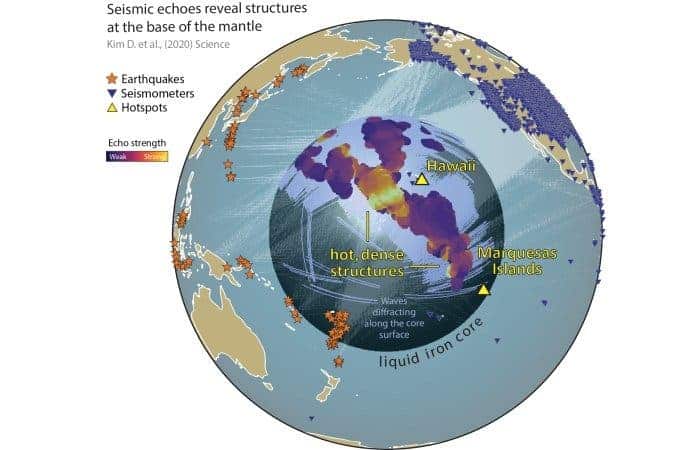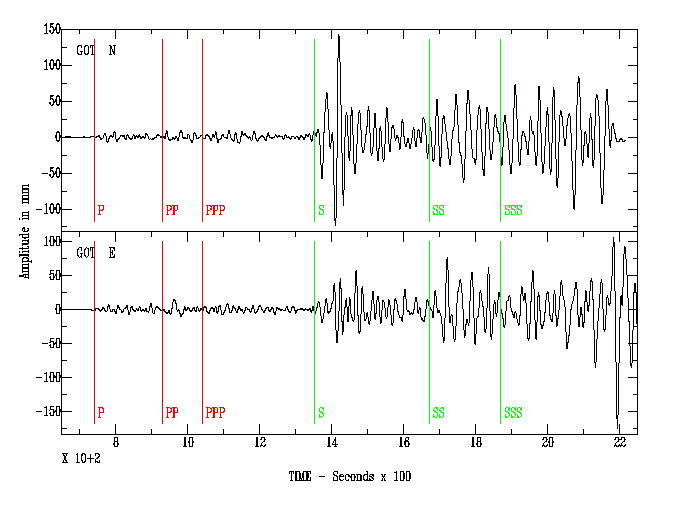Our planet’s core might be pockmarked with hot blobs. We don’t know what they are, we don’t know where they’re from, but according to a new study, they’re there.

Ever stopped and wondered just how we know so much about the Earth’s interior? Since we’re kids, we’re told that the Earth has a crust, a mantle, and a core, but how do we know this? The Earth’s radius measures thousands of kilometers, and the deepest hole mankind has ever dug only goes down to 10 km, so it’s not like we actually went there and saw what was going on.
Most of the information we have about the Earth’s structure comes from earthquakes.
When an earthquake takes place, it sends out seismic waves in all directions. These waves are essentially acoustic waves, propagating throughout the planet’s interior. Seismologists detect these waves using specialized stations placed all around the world, and by analyzing these waves, they can understand some of the properties of the planet’s structure, similar to an ultrasound. This is exactly what happened here.
Researchers looked at echoes generated by a specific type of wave. This particular type of wave travels along the core-mantle boundary and is called a shear wave. But looking for a single wave on a seismogram is very challenging — the wave from your earthquake needs to travel to the planet’s core and then back to the surface, where we can detect it. So instead, researchers tried a different approach.

Using a machine-learning algorithm, they analyzed 7,000 seismograms from hundreds of big earthquakes around the Pacific Ocean from 1990 to 2018, looking for similarities and patterns in the data. A smudge in the seismograph might be a coincidence, but the same smudge in hundreds of seismograms has meaning — and in this case, researchers found quite a few smudges.

The findings suggest that there are widespread areas around the Earth’s core where seismic waves travel at a lower-than-normal velocity. These low-velocity areas are thought to represent hot, molten blobs — and according to this study, the core is much more blobby than we thought.
In particular, the team found a lot of these hot blobs under the Marquesas Islands, a group of volcanic islands about halfway between South American and Australia.
“We were surprised to find such a big feature beneath the Marquesas Islands that we didn’t even know existed before,” said geologist Vedran Lekić of the University of Maryland.
“This is really exciting, because it shows how the algorithm can help us to contextualise seismogram data across the globe in a way we couldn’t before.”
The algorithm itself shows great promise. It’s called Sequencer and was designed to run through large astronomical datasets looking for patterns. Now that researchers have adapted it to different types of data, and this first find is already exciting.
“We were surprised to find such a big feature beneath the Marquesas Islands that we didn’t even know existed before,” said Vedran Lekić, an associate professor of geology at UMD and a co-author of the study. “This is really exciting, because it shows how the Sequencer algorithm can help us to contextualize seismogram data across the globe in a way we couldn’t before.”
Researchers knew that some of these can exist, but they turned out to be much more common than expected — potentially hinting that they may also be present in other areas of the planet’s interior.
“We found echoes on about 40% of all seismic wave paths,” Lekić said . “That was surprising because we were expecting them to be more rare, and what that means is the anomalous structures at the core-mantle boundary are much more widespread than previously thought.”
In addition, since the Sequencer algorithm has already proven to be quite robust, researchers say that it could potentially be adapted to other types of research as well.
“Exploring a large dataset with the Sequencer enables a data-driven analysis of seismic waveforms without any prior expectations. We anticipate this approach to be useful for many types of datasets beyond seismograms,” the researchers conclude.
Journal Reference: D. Kim, V. Lekić, B. Ménard, D. Baron and M. Taghizadeh-Popp. Sequencing Seismograms: A Panoptic View of Scattering in the Core-Mantle Boundary Region. Science, 2020 DOI: 10.1126/science.aba8972






